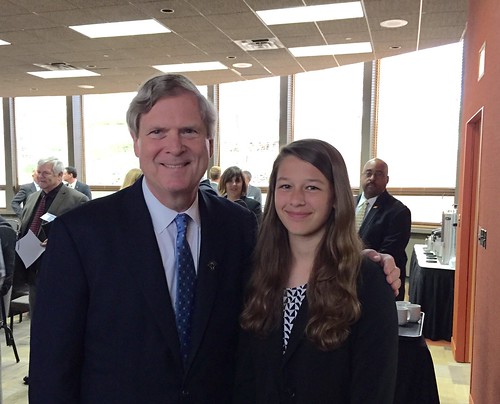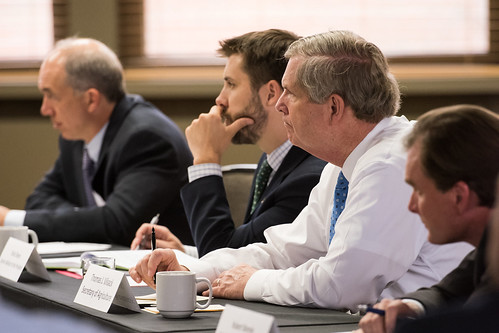
Ellie Hohenstein in Michigan with Agriculture Secretary Tom Vilsack. (USDA photo)
Last week, Secretary Vilsack went to Michigan State University to deliver a major climate address. Among those in attendance was 15 year old Ellie Hohenstein, a freshman at Annandale High School in Fairfax County, VA. She provides this blog concerning her experiences as she accompanied her father to Lansing for the event. Wayne Maloney, Office of Communications
Submitted by Ellie Hohenstein
My father is the Director of the USDA Climate Change Program Office in Washington, D.C. April 23 was “bring your daughter or son to work day” at USDA. I had no idea what to expect when my Dad told me I could accompany him on his business trip to Michigan. I knew I would get to watch a speech from the Secretary of Agriculture, but this was a much bigger event than I expected.
Just minutes after arriving in our hotel at nine o’clock at night, we began a walkthrough of the rooms that would be used for the event. The next morning I got to sit in and watch as my dad and two others briefed Secretary Vilsack on the day to come.
I then tagged along for the Secretary’s big speech and saw him answer questions from reporters. I was very impressed with the way Secretary Vilsack handled questions and kept things moving while still informing everyone.
I also had the opportunity to eat lunch with three producers who are leaders in reducing carbon emissions. Bob Giacomini is a dairy farmer from California who makes cheese. Jamie Scott is a corn and soybean farmer from Indiana. Donn Branton is a farmer from New York that grows lots of different crops. Donn told me that the activities USDA is proposing to reduce greenhouse gases and sequester carbon are not new ideas, and have actually been around for a while. He got to where he is today through experimentation, and his neighbors are now following his example after doubting him when he first started. While talking with and listening to these producers I learned many things. I learned what a digester is, and other ways that farms and ranches can reduce their carbon output. Other beneficial practices include reduced/no tilling, and using cover crops. The farmers were very professional, interesting, and innovative.
The learning didn’t stop there. While watching the speech and sitting in on a roundtable following the event, I learned how this announcement consisted of ten new building blocks for producers to follow if they choose to. Participation is entirely voluntary, and producers get incentives to improve the environment. I found it odd that there was a representative from General Motors at the round table. Why would a car company be at an agricultural event? As it turns out, General Motors is buying carbon credits from farmers for storing carbon. I thought it was cool how agriculture doesn’t just involve farmers and ranchers, it affects everyone. I knew that agriculture had a big impact, but this experience showed me just how important it is and how much affect it has on the Earth and all of us.

Agriculture Secretary Tom Vilsack, Senior Advisor to the President Brian Deese, U.S. Department of Agriculture (USDA) Natural Resources and Environment (NRE) Under Secretary Robert Bonnie and USDA Office of Chief Economist (OCE) Climate Change Program Office Director William Hohenstein lead a roundtable discussion on climate change issues at Michigan State University.
No comments:
Post a Comment
Note: Only a member of this blog may post a comment.